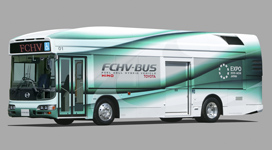Fuel cell hybrid bus
The fuel cell hybrid bus operates on motors powered by high-pressure hydrogen-supplied fuel cells and a nickel-metal hydride secondary battery. Unlike gasoline- and diesel-fueled vehicles, it does not emit carbon dioxide or other toxic substances during operation and is highly energy-efficient, as well as quiet.

The FCHV-BUS2 fuel cell hybrid bus
(An improved version is due to operate at EXPO 2005 Aichi, Japan.)
Overview
The fuel cell hybrid buses to be used at EXPO 2005 Aichi, Japan will represent an improved version of the FCHV-BUS2-a large low-floor commuter bus that features a hybrid system powered by high-pressure hydrogen and that TMC and Hino Motors, Ltd. have been jointly developing since 2000.
The FCHV-BUS2, equipped with two units of TMC's high-performance Toyota FC Stack and incorporating the hybrid technologies found in the Toyota Prius hybrid passenger sedan and Hino's HIMR System, achieves high running efficiency by recovering energy during deceleration and delicately alternating between its fuel cells and secondary battery for power supply to the motor according to running conditions.
The FCHV-BUS2 was the first fuel cell-powered bus officially approved by Japan's Ministry of Land, Infrastructure and Transportation. Issued a license plate in 2002, the vehicle has been carrying out trial runs on public roads. It is also expected to run on regular Tokyo metropolitan bus routes this summer as part of a fuel cell bus pilot project promoted by the Tokyo Metropolitan Government.
Technical features
As explained above, the fuel cell buses that will operate at EXPO 2005 Aichi, Japan will represent an improved version of the FCHV-BUS2. The main specifications of the current FCHV-BUS2 are as follows:
Vehicle
Base platform
Blue Ribbon City (Hino low-floor commuter bus)
Overall length / width / height
10,515 / 2,490 / 3,360 mm
Maximum speed
80 km/h
Occupant capacity
60 people
Fuel cell stack
Type
Polymer electrolyte fuel cell
Output
90 kW x 2
Motor
Type
Permanent magnet
Maximum output
80 kW x 2
Maximum torque
260 Nm x 2
Fuel
Type
Pure hydrogen
Storage method
High-pressure hydrogen storage tank
Maximum storage pressure
35 MPa (350 atmospheres)
Secondary battery
Type
Nickel-metal hydride
At EXPO 2005 Aichi, Japan
At EXPO 2005 Aichi, Japan, the improved fuel cell hybrid buses will operate as follows:
- Period: March 25 - Sept. 25, 2003 (185 days)
- Hours: 9 a.m. - 6 p.m. (tentative)
- Service area: Between the Nagakute and Seto areas (about 3.5 km)
- Traveling time: about 10 minutes (one way)
- Departure intervals: Every 6 - 8 minutes
- Passenger capacity: Approximately 900 - 1,200 passengers/hour, round-trip


